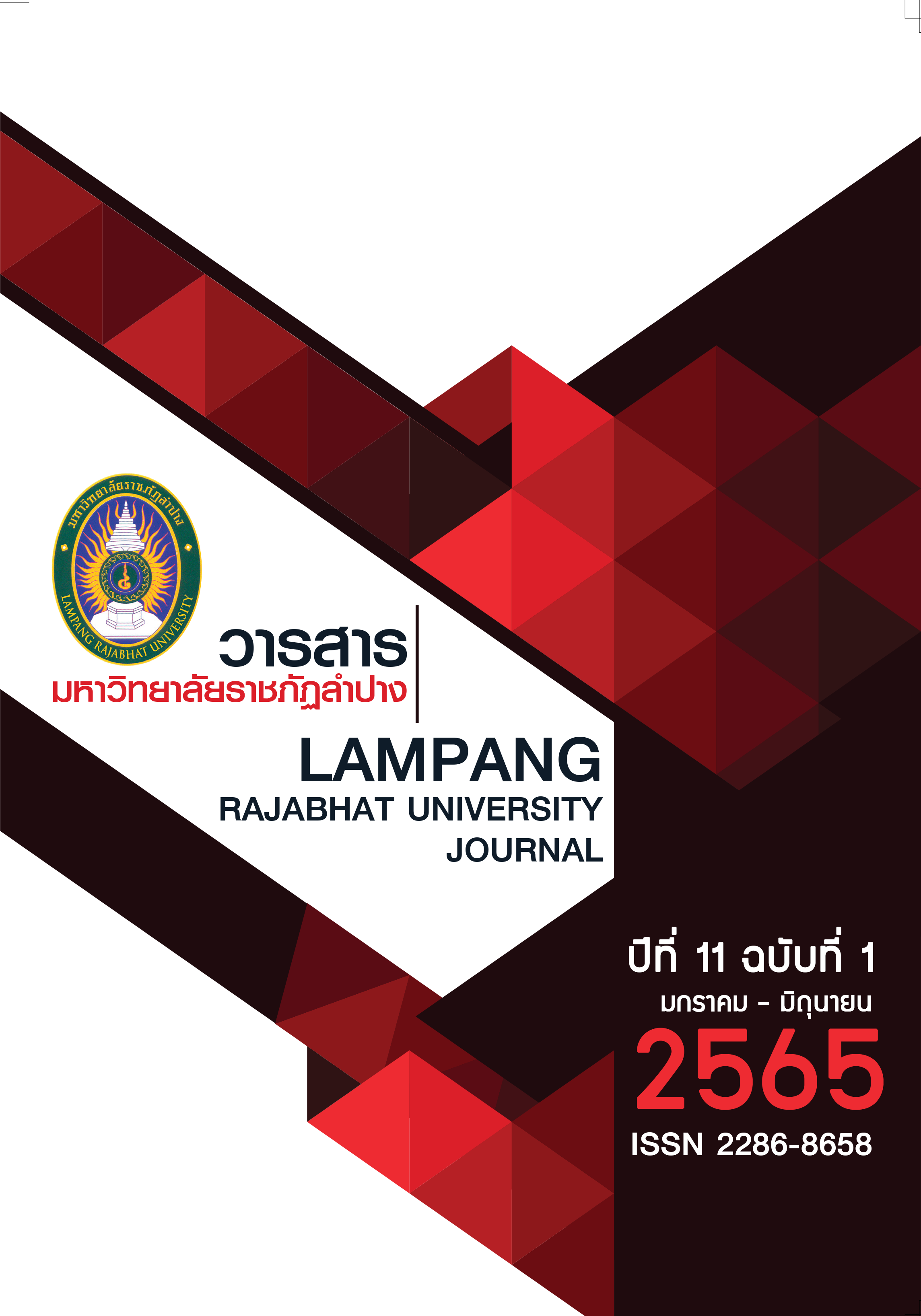Scientific Reasoning Ability on the learning unit of heat energy of Grade-7 Students Learning Through PSOE
Keywords:
Scientific Reasoning, PSOE ApproachAbstract
The objective of this research is to study scientific reasoning ability on the learning unit of heat energy among grade-7 students engaged through PSOE approach. The sample for this research were 30 grade-7 students of Lampang Kanlayanee School, Muang District, Lampang Province. This research was carried out in the second semester of academic year 2019. The research instruments were 1) a total of 5 lesson PSOE-based teaching plans (OIC > 0.67) and 2) a scientific reasoning ability test (0.2 < p < 0.8, r > 0.2, KR-20 = 0.88). The result indicates that the average scientific reasoning ability post score is significantly higher than the average pre score (paired t-test, p < 0.05). Considering the components of scientific reasoning, including claim, evidence and justification of the claim and evidence, the result reveals that only 20 percent of students made a claim based on evidence and could justify how the claim and the evidence are related. When Considering the teaching content, it was found that students can do the best scientific reasoning’s score on the topic of heat transfer.
References
กระทรวงศึกษาธิการ. (2552). หลักสูตรแกนกลางการศึกษาขั้นพื้นฐาน พุทธศักราช 2551. กรุงเทพฯ: โรงพิมพ์ชุมนุมสหกรณ์การเกษตรแห่งประเทศไทย.
กาญจนา มหาลี และชาตรี ฝ่ายคำตา. (2553). ความเข้าใจธรรมชาติวิทยาศาสตร์ของนักเรียนชั้นมัธยมศึกษาปีที่ 1. วารสารสงขลานครินทร์ ฉบับสังคมศาสตร์และมนุษยศาสตร์. 16(5), 795 - 809.
กฤตกร สภาสันติกุล. (2554). ผลของกลวิธีการสอนเคมีโดยใช้การทำนาย การสังเกต การอธิบาย อย่างมีขั้นตอนที่มีต่อความสามารถในการสร้างคำอธิบายทางวิทยาศาสตร์และความมีเหตุผลของนักเรียนชั้นมัธยมศึกษาปีที่ 4. (วิทยานิพนธ์ปริญญามหาบัณฑิต). กรุงเทพฯ.จุฬาลงกรณ์มหาวิทยาลัย. [ระบบออนไลน์], สืบค้นจาก http://cuir.car.chula.ac.th/ handle/123456789/51073.
จิรพรรณ คงเคารพธรรม. (2553). การพัฒนาการเรียนการสอนวิชาคณิตศาสตร์ระดับ ประกาศนียบัตร วิชาชีพชั้นสูงเรื่องเศษส่วนย่อย โดยใช้ทฤษฎีคอนสตรัคติวิสซึม. วิทยานิพนธ์ปริญญาวิทยาศาสตรมหาบัณฑิต มหาวิทยาลัยราชภัฏอุบลราชธานี.
เมธิน อินทรประสิทธิ์. (2558). ผลของกลวิธีการสอนทำนาย-อภิปราย-อธิบาย-สังเกต-อภิปราย-อธิบายที่มีต่อความเข้าใจมโนทัศน์และผลสัมฤทธิ์ทางการเรียนรู้เคมีของนักเรียนชั้นมัธยมศึกษาตอนปลาย. กรุงเทพฯ: สำนักพิมพ์แห่งจุฬาลงกรณ์มหาวิทยาลัย.
ลือชา ลดาชาติ และลฎาภา สุทธกูล. (2555). การสำรวจและพัฒนาความเข้าใจธรรมชาติของวิทยาศาสตร์ของนักเรียนชั้นมัธยมศึกษาปีที่ 4. วารสารมหาวิทยาลัยนราธิวาสราชนครินทร์, 4(2),73-90.
สถาบันส่งเสริมการสอนวิทยาศาสตร์และเทคโนโลยี. (2557). ผลการประเมิน PISA 2012 การอ่าน คณิตศาสตร์ และวิทยาศาสตร์. [ระบบออนไลน์], สืบค้นจาก http://pisathailand. ipst.ac.th/, เข้าดูเมื่อวันที่ 2/03/2558.
สถาบันส่งเสริมการสอนวิทยาศาสตร์และเทคโนโลยี. (2560). คู่มือการใช้หลักสูตรรายวิชาพื้นฐานวิทยาศาสตร์ระดับมัธยมศึกษาตอนต้น. กรุงเทพฯ: สถาบันส่งเสริมการสอนวิทยาศาสตร์และเทคโนโลยี.
สถาบันส่งเสริมการสอนวิทยาศาสตร์และเทคโนโลยี. (2560). รายงานผลการวิจัยโครงการ TIMSS 2015 วิชาวิทยาศาสตร์. กรุงเทพฯ: สถาบันส่งเสริมการสอนวิทยาศาสตร์และเทคโนโลยี.
สุมาลี ชัยเจริญ. (2551). เทคโนโลยีการศึกษา : หลักการ ทฤษฎีสู่การปฏิบัติ. ขอนแก่น: คลังนานาวิทยา.
Fosnot, C.T. (1996). Constructivism: Theory, Perspective and Practice. New York: Teacher College Press.
International Association for the Evaluational Achievement (IEA). (2015). TIMSS 2015 International Results in Science. USA: TIMSS & PIRLS International Study Center.
Peker, D., Wallace, C. S. (2011). Characterizing high school students’ written explanation in biology laboratories. Research in Science Education, 41(2),169-191.
Downloads
Published
How to Cite
Issue
Section
License
Copyright (c) 2021 Lampang Rajabhat University Journal

This work is licensed under a Creative Commons Attribution-NonCommercial-NoDerivatives 4.0 International License.
บทความลิขสิทธิ์ของวารสารมหาวิทยาลัยราชภัฎลำปาง






